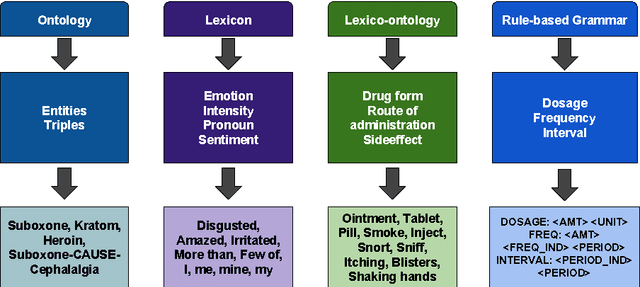Sanjaya Wijeratne
A Semantics-Based Measure of Emoji Similarity
Jul 14, 2017



Abstract:Emoji have grown to become one of the most important forms of communication on the web. With its widespread use, measuring the similarity of emoji has become an important problem for contemporary text processing since it lies at the heart of sentiment analysis, search, and interface design tasks. This paper presents a comprehensive analysis of the semantic similarity of emoji through embedding models that are learned over machine-readable emoji meanings in the EmojiNet knowledge base. Using emoji descriptions, emoji sense labels and emoji sense definitions, and with different training corpora obtained from Twitter and Google News, we develop and test multiple embedding models to measure emoji similarity. To evaluate our work, we create a new dataset called EmoSim508, which assigns human-annotated semantic similarity scores to a set of 508 carefully selected emoji pairs. After validation with EmoSim508, we present a real-world use-case of our emoji embedding models using a sentiment analysis task and show that our models outperform the previous best-performing emoji embedding model on this task. The EmoSim508 dataset and our emoji embedding models are publicly released with this paper and can be downloaded from http://emojinet.knoesis.org/.
EmojiNet: An Open Service and API for Emoji Sense Discovery
Jul 14, 2017



Abstract:This paper presents the release of EmojiNet, the largest machine-readable emoji sense inventory that links Unicode emoji representations to their English meanings extracted from the Web. EmojiNet is a dataset consisting of: (i) 12,904 sense labels over 2,389 emoji, which were extracted from the web and linked to machine-readable sense definitions seen in BabelNet, (ii) context words associated with each emoji sense, which are inferred through word embedding models trained over Google News corpus and a Twitter message corpus for each emoji sense definition, and (iii) recognizing discrepancies in the presentation of emoji on different platforms, specification of the most likely platform-based emoji sense for a selected set of emoji. The dataset is hosted as an open service with a REST API and is available at http://emojinet.knoesis.org/. The development of this dataset, evaluation of its quality, and its applications including emoji sense disambiguation and emoji sense similarity are discussed.
Knowledge will Propel Machine Understanding of Content: Extrapolating from Current Examples
Jul 14, 2017



Abstract:Machine Learning has been a big success story during the AI resurgence. One particular stand out success relates to learning from a massive amount of data. In spite of early assertions of the unreasonable effectiveness of data, there is increasing recognition for utilizing knowledge whenever it is available or can be created purposefully. In this paper, we discuss the indispensable role of knowledge for deeper understanding of content where (i) large amounts of training data are unavailable, (ii) the objects to be recognized are complex, (e.g., implicit entities and highly subjective content), and (iii) applications need to use complementary or related data in multiple modalities/media. What brings us to the cusp of rapid progress is our ability to (a) create relevant and reliable knowledge and (b) carefully exploit knowledge to enhance ML/NLP techniques. Using diverse examples, we seek to foretell unprecedented progress in our ability for deeper understanding and exploitation of multimodal data and continued incorporation of knowledge in learning techniques.
Finding Street Gang Members on Twitter
Oct 29, 2016



Abstract:Most street gang members use Twitter to intimidate others, to present outrageous images and statements to the world, and to share recent illegal activities. Their tweets may thus be useful to law enforcement agencies to discover clues about recent crimes or to anticipate ones that may occur. Finding these posts, however, requires a method to discover gang member Twitter profiles. This is a challenging task since gang members represent a very small population of the 320 million Twitter users. This paper studies the problem of automatically finding gang members on Twitter. It outlines a process to curate one of the largest sets of verifiable gang member profiles that have ever been studied. A review of these profiles establishes differences in the language, images, YouTube links, and emojis gang members use compared to the rest of the Twitter population. Features from this review are used to train a series of supervised classifiers. Our classifier achieves a promising F1 score with a low false positive rate.
* 8 pages, 9 figures, 2 tables, Published as a full paper at 2016 IEEE/ACM International Conference on Advances in Social Networks Analysis and Mining (ASONAM 2016)
Word Embeddings to Enhance Twitter Gang Member Profile Identification
Oct 27, 2016


Abstract:Gang affiliates have joined the masses who use social media to share thoughts and actions publicly. Interestingly, they use this public medium to express recent illegal actions, to intimidate others, and to share outrageous images and statements. Agencies able to unearth these profiles may thus be able to anticipate, stop, or hasten the investigation of gang-related crimes. This paper investigates the use of word embeddings to help identify gang members on Twitter. Building on our previous work, we generate word embeddings that translate what Twitter users post in their profile descriptions, tweets, profile images, and linked YouTube content to a real vector format amenable for machine learning classification. Our experimental results show that pre-trained word embeddings can boost the accuracy of supervised learning algorithms trained over gang members social media posts.
* 7 pages, 1 figure, 2 tables, Published at IJCAI Workshop on Semantic Machine Learning (SML 2016)
EmojiNet: Building a Machine Readable Sense Inventory for Emoji
Oct 25, 2016



Abstract:Emoji are a contemporary and extremely popular way to enhance electronic communication. Without rigid semantics attached to them, emoji symbols take on different meanings based on the context of a message. Thus, like the word sense disambiguation task in natural language processing, machines also need to disambiguate the meaning or sense of an emoji. In a first step toward achieving this goal, this paper presents EmojiNet, the first machine readable sense inventory for emoji. EmojiNet is a resource enabling systems to link emoji with their context-specific meaning. It is automatically constructed by integrating multiple emoji resources with BabelNet, which is the most comprehensive multilingual sense inventory available to date. The paper discusses its construction, evaluates the automatic resource creation process, and presents a use case where EmojiNet disambiguates emoji usage in tweets. EmojiNet is available online for use at http://emojinet.knoesis.org.
 Add to Chrome
Add to Chrome Add to Firefox
Add to Firefox Add to Edge
Add to Edge